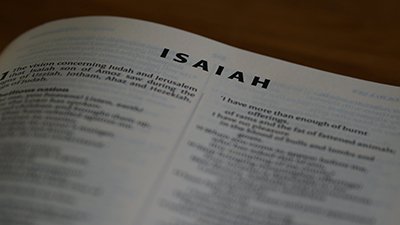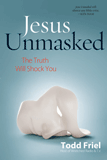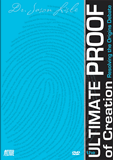Evolution and the Atonement of Jesus Christ
Recently, the BioLogos website hosted two articles from guest blogger Dr. Joseph Bankard as part of a series on “how to understand the atoning work of Christ in light of evolutionary science.” This series features writers who hold different opinions on the relationship between evolution and the atonement. Critiques of some of these posts are forthcoming. This article will summarize the main points in Dr. Bankard’s posts and then offer a critique of these points.
Bankard’s Claims
In his first post, Bankard explains his objections to the orthodox understanding of the atonement, known as the penal substitutionary atonement. This view states that Jesus died as our substitute on the Cross, appeasing the wrath of God against sin and satisfying the demands of God’s perfect justice.
Bankard argues that if the substitutionary atonement view is true then “God is either severely limited in power or unnecessarily cruel.”1 What is his rationale for this claim? If God can only forgive sin through blood and sacrifice, then He must be limited in power, and if God could forgive humanity in other ways but chooses the torture and death of His Son, then He seems to be quite cruel. Bankard goes one step further and states that he doesn’t think God willed the Cross because then God would have willed sinful actions. Instead, he says, Christ’s “crucifixion was the result of human sin.”
His second objection to the substitutionary atonement view is based squarely on his acceptance of molecules-to-man evolution. If humans evolved from primates, then the historicity of Adam and Eve is unlikely, meaning that they never brought humanity into a state of sin, which ultimately would be resolved by Christ’s sacrificial death on the Cross. Bankard’s statement about evolution’s impact on the Cross perfectly illustrates what Answers in Genesis has constantly told Christian leaders.
Substitutionary atonement sees original sin as a major reason for Christ’s death. But macroevolution calls the Fall and the doctrine of original sin into question. Thus, evolution poses a significant challenge to substitutionary atonement.2
Bankard’s second article focuses on his view of the atonement, or rather the Incarnation. His view of the Cross is more about Jesus experiencing what it’s like to be human so that He can really connect with us. As such, his view of the Cross has little, if anything, to do with atoning for man’s sin. Instead of focusing on the Cross, Bankard focuses on Christ’s life, arguing that the primary reason Jesus came was to show us how to truly be human—to show us what kingdom living really looks like. This functional view of salvation is consistent with recent articles on the BioLogos website that redefine the image of God to fit with evolutionary ideas. See “Evolution and What the Image of God Is Not” and “What Is the Image of God?” for an evaluation of this notion.
Critique
Bankard’s posts contain numerous theological errors and logical fallacies. His belief in evolution has clouded his reading of Scripture. For example, he claims that problems with a literal reading of Genesis led him away from interpreting the Bible’s earliest chapters in a straightforward manner. However, these “problems” are easily addressed.
Problems in Genesis?
He stated that as a young adult he was “deeply troubled by the divergent creation stories in Genesis 1 and 2.” These chapters do not contradict each other; they complement one another. Genesis 1–2:4 provides a broad overview of the Creation Week, while Genesis 2 zooms in on events that occurred on Day Six.
Bankard wondered how the word day could really refer to a 24-hour time period. “How could there be a day before the sun was created?” However, the sun is not required to mark the passing of a 24-hour time period on Earth. We use the sun today to recognize the start and end of a day, but it certainly is not required for timekeeping. God created light on Day One, and it seems that the Earth was rotating as well since there was a period of darkness and a period of light—the first day.
The account of Cain is said to be even more problematic. Cain moved to the land of Nod after killing Abel. But this troubled Bankard, and he asked, “Where on earth did all the people in Nod come from?” The Bible does not say that there were already people in the land of Nod when Cain traveled there. He brought his wife with him, and then he built a city. Obviously, the original inhabitants of Nod and the city of Enoch were Cain’s descendants.
Evolution Drives Theology
The theological rationale in these articles leaves much to be desired. It does not follow that if God only forgives sin through blood and sacrifice that He must be limited in power. The truth is that Scripture plainly states that death is the penalty for sin. God told Adam that if he ate from the fruit of the tree of the knowledge of good and evil that he would surely die (Genesis 2:17). Romans 6:23 tells us that “the wages of sin is death.” This is why the solution to the problem of sin and death is the Crucifixion and Resurrection of Jesus Christ. If Adam’s sin did not bring physical death into this world, then the physical death of Christ on the Cross and His physical, bodily Resurrection from the dead have no connection with sin. Far from being limited in power, God demonstrates His power over sin and death by raising His Son from the dead.
Yet Bankard, based on his understanding of the evolutionary origin of man, does not believe Adam and Eve ever existed,3 so death cannot be the penalty for sin. Death must have existed for hundreds of millions of years before the first humans evolved.
Through the death of the perfect Man, God’s perfect justice is satisfied since sin requires death.
It also does not follow that since He chose to send His Son to die for our sins that He must be unnecessarily cruel. This might be the case if God sent an unwilling and unqualified person to die on the Cross. We must remember that God is triune, that the Son is also God. God became a man, and He willingly chose to lay down His life for our sins. Our Creator and Judge became one of us and took upon Himself the sins of the world so that we could be reconciled to Him. Through the death of the perfect Man, God’s perfect justice is satisfied since sin requires death. “For since by man came death, by Man also came the resurrection of the dead. For as in Adam all die, even so in Christ all shall be made alive
” (1 Corinthians 15:21–22).
The penal substitutionary atonement view of Christ’s death has been widely accepted by Bible-believing Christians for centuries. As such, many may be surprised that numerous views of the atonement have existed throughout church history. For example, Irenaeus (c. 125–202) proposed the recapitulation theory, Augustine (354–430) held to the ransom theory, and Anselm (1033–1109) developed the necessary-satisfaction theory.
Space does not allow for an evaluation of each of these other positions, but two points can be made. First, while each of these views can find some support in Scripture, they are at odds with other portions of the text, and as such, they are insufficient explanations of the atonement. Second, these views were developed in an attempt to explain certain ideas found in the Bible.
Bankard’s position is different than these other views of the atonement in that he bases it on a concept found nowhere in Scripture (evolution) and uses that foreign concept to reinterpret the words of the Bible. Consider his own words describing his rationale in searching for an alternate view of the atonement.
In my estimation, substitutionary atonement does not fit well with the theory of evolution.4
If evolution is true, then the universe is very old, humans evolved from primates, and the historical accuracy (but not the truth) of the Genesis narratives is called into question.5
The substitutionary view argues that Jesus’ death redeems the sin committed by Adam and Eve in the garden. To adopt this view, one must read Genesis 1–3 more literally. At times, this kind of biblical hermeneutic may run counter to evolutionary theory. The view sketched above does not require a historical Adam and Eve or a traditional concept of original sin, making it more compatible with evolution.6
Commentary is hardly needed on these points since Bankard rightly states that evolution contradicts the historical accuracy of Genesis. He argues that if one interprets Genesis metaphorically or allegorically then one can still hold to the truth of the Genesis narratives. This would be accurate if Genesis were intended to be taken allegorically, but the biblical evidence against this notion is overwhelming. Jesus treated these early chapters as literal history, as did any author of Scripture who referred to them. For example, Paul built entire arguments on the truth that Adam’s sin brought death into the world (Romans 5:12–21; 1 Corinthians 15:21–22). Furthermore, Luke 3 lists the genealogy of Jesus all the way back to Adam. But if Adam was not a real person, then how could Jesus be descended from him?
Denying God’s Plan
Throughout the articles, Bankard seems to conflate the atonement with the Incarnation. When he starts to speak of the atonement, he changes gears to discuss Christ’s life rather than His death. This is because he believes that we are saved by Christ’s life and the example He set—not by His atoning work at the Cross.
The most troubling aspect of Bankard’s article is his outright denial of Christ’s substitutionary atonement. In his second article, he attempts to explain that Jesus came not to die for man, but to experience life as a man. Throughout his post, he sets up the two ideas as though one must choose one view over another. He states that according to the substitutionary view, “God becomes human in the person of Jesus of Nazareth with the sole purpose of dying for humanity’s sin. But I argue that this view of the incarnation is somewhat limited. Jesus doesn’t become human to die. Jesus takes on flesh and bone to show us how to really live, how to be fully human.”7
By setting up the argument in this way, Bankard commits the logical fallacy of bifurcation (the either/or fallacy). He gives the reader the choice of only two options when at least one more is available. He misrepresents the substitutionary view by claiming that Christ’s death was the “sole purpose” for the incarnation. This is absolutely false, and it would be wrong for us to think that Jesus became a man for only one purpose. He came because God so loved the world (John 3:16). He came so that He could experience humanity and become our high priest who can sympathize with our weaknesses (Hebrews 4:15). He came to fulfill prophecy (Matthew 1:22–23). He came to save sinners (1 Timothy 1:15). And yes, He most certainly came to die on the Cross (John 19:28–30).
Christ’s death was absolutely part of God’s divine plan.
Sadly, Bankard apparently denies the last statement above. He states that “Christ’s death was not part of God’s divine plan. It was the tragic result of human sin.” Besides another obvious bifurcation fallacy (Christ’s death was both part of God’s divine plan and the result of human sin), the Bible explicitly teaches in a number of ways that Christ’s death was absolutely part of God’s divine plan.
We are told in Revelation 13:8 that Jesus is the “Lamb slain from the foundation of the world.” The Crucifixion and Resurrection of the Messiah were part of God’s plan before He ever created us. He knew man would rebel, and He already knew how man would be redeemed. The Old Testament prophesied that the Messiah would be killed, but not for Himself (Daniel 9:26; Isaiah 53:8–9). The psalmist even gave us a glimpse of the form of execution by which the Messiah would die (Psalm 22:14–18). Jesus told people several times that He was going to die (Matthew 12:39–40, 20:17–19; John 2:19, 12:32–33).
If these clear statements about the Messiah’s death were not enough, the Bible teaches us that the death of Jesus Christ was the only way for sinners to be saved. On the night that He was arrested, Jesus pleaded with the Father, “O My Father, if it is possible, let this cup pass from Me; nevertheless, not as I will, but as You will
” (Matthew 26:39). Knowing all that was about to happen to Him, Jesus asked the Father to find a way other than the Cross to save sinners. Yet the fact that He still endured the Cross demonstrated that there could be no other way to save sinners.
Ironically, it is Bankard’s view that makes God unnecessarily cruel. If evolution were true, then God willed the deaths of trillions of creatures for millions of years. He also sent His Son to live on earth to show us the perfect example of humanity. But if the cross was not required to save sinners, then why did God permit Jesus to face such torture if it wasn’t even necessary? Was He powerless to stop it?
Finally, the Apostle Paul summarized the gospel message he preached.
Moreover, brethren, I declare to you the gospel which I preached to you, which also you received and in which you stand, by which also you are saved, if you hold fast that word which I preached to you—unless you believed in vain. For I delivered to you first of all that which I also received: the Christ died for our sins according to the Scriptures, and that He was buried, and that He rose again the third day according to the Scriptures. (1 Corinthians 15:3–4, emphasis added)
For He made Him who knew no sin to be sin for us, that we might become the righteousness of God in Him. (2 Corinthians 5:21)
The message that saves souls is the message about the substitutionary death, burial, and Resurrection of Jesus Christ.
Conclusion
Answers in Genesis has repeatedly stated that salvation is not contingent upon one’s acceptance of the straightforward reading of the Creation account, since salvation is based on the atoning death, burial, and Resurrection of Jesus Christ (1 Corinthians 15:3–4). However, we have also warned the church for over 20 years that the acceptance of the billions of years necessarily undermines crucial Christian doctrines, including the gospel message itself.
Dr. Bankard’s articles seek to find a new understanding of the Lord’s death in an evolutionary worldview, and this new understanding demonstrates the accuracy of our warnings. By elevating evolutionary beliefs about the past above the truth of Scripture, Dr. Bankard strays into error by denying key elements of Christ’s sacrifice and its purpose that are clearly spelled out in Scripture.
Footnotes
- Bankard’s claim that the substitutionary atonement view makes God unnecessarily cruel is not original. For an example of a Christian who makes this claim, see Steve Chalke, The Lost Message of Jesus. Sadly, Christians who use this argument are following in the footsteps of many skeptics who criticize Christ’s sacrificial death in this manner.
- Bankard, “Substitutionary Atonement and Evolution, Part 1,” BioLogos, June 9, 2015, http://biologos.org/blog/substitutionary-atonement-and-evolution-part-1.
- Bankard acknowledges that some theistic evolutionists accept the existence of Adam and Eve as the first two people.
- Bankard, “Substitutionary Atonement and Evolution, Part 1.”
- Ibid.
- Bankard, “Substitutionary Atonement and Evolution, Part 2,” BioLogos, June 10, 2015, http://biologos.org/blog/substitutionary-atonement-and-evolution-part-2.
- Ibid.
Recommended Resources

Answers in Genesis is an apologetics ministry, dedicated to helping Christians defend their faith and proclaim the good news of Jesus Christ.
- Customer Service 800.778.3390
- © 2024 Answers in Genesis







